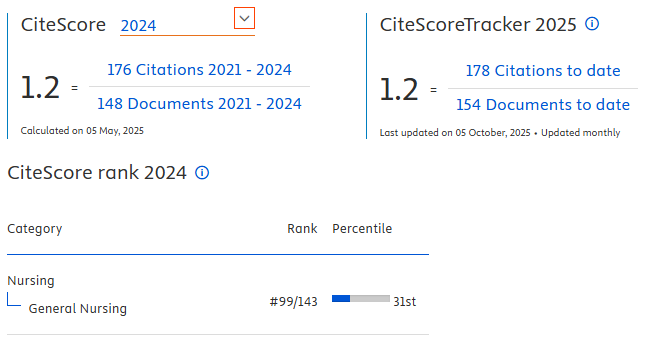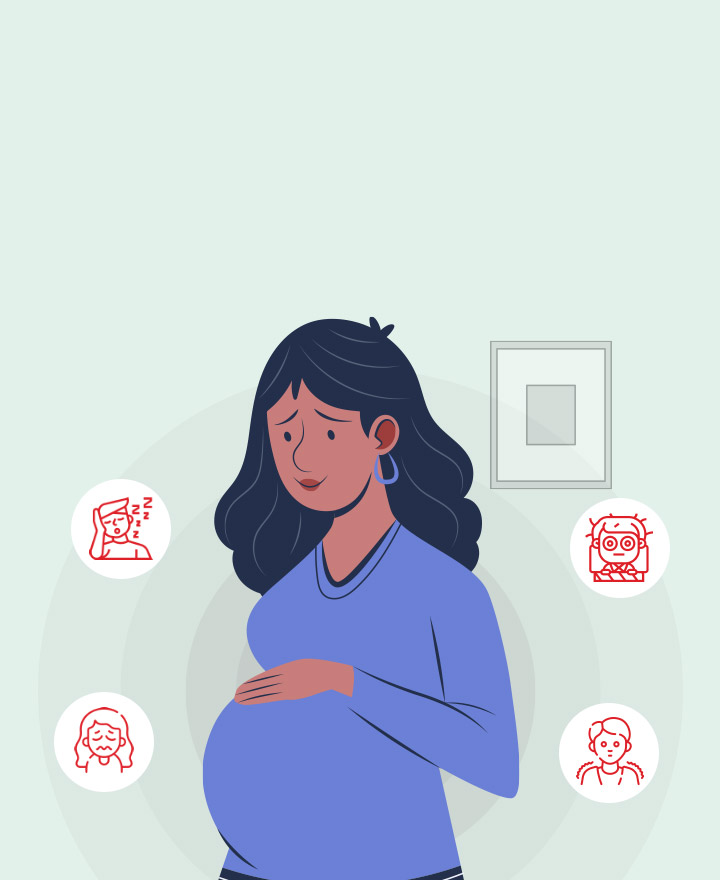The impact of self-care behavior on quality of life among patients with heart failure in Malaysia: a cross-sectional study

Downloads
Introduction: Individuals with heart failure anticipate adjustment to self-care behaviors following hospital discharge. Self-care in heart failure includes medication adherence, dietary modifications, symptom monitoring, and activity adjustment. Adequate self-care behavior may contribute to enhanced outcomes, decreased hospitalization, and improved quality of life in patients with heart failure. This study aimed to determine the level of self-care behavior, quality of life, and its relationships among patients with heart failure.
Methods: A cross-sectional study using purposive sampling was conducted among 200 heart failure patients at a teaching hospital in Selangor, Malaysia. The sample size was determined using G*Power to ensure adequate statistical power. Data were collected using the Self-Care of Heart Failure Index (SCHFI) and the Minnesota Living with Heart Failure Questionnaire (MLHFQ). Descriptive statistics, Pearson’s correlation, and multiple linear regression were used in this study.
Results: The results indicated that the total mean score of self-care behavior was 145.42 and SD=16.23. Most patients demonstrated good quality of life (n=73, 36.5%), moderate quality of life (n=62, 31%), and poor quality of life (n=65, 32.5 %). Pearson's correlation revealed a significant (p<0.001) correlation (r = 0.651) between self-care behavior and quality of life.
Conclusions: In conclusion, this study demonstrated that higher levels of self-care are associated with better quality of life in patients with heart failure. It is recommended that nurses provide individualized self-care education at discharge, focusing on medication adherence, symptom monitoring, and lifestyle changes to improve quality of life.
AbuRuz, M. E., & Alaloul, F. (2018). Comparison of quality of life between Jordanian and Saudi patients with heart failure. Global Journal of Health Science, 10(7), 96.
Alkan, S., & Nural, N. (2017). Evaluation of Symptoms and Predictors in Patients with Heart Failure in Turkey. Journal of Hospice and Palliative Nursing, 19(5), 404–412. https://doi.org/10.1097/NJH.0000000000000382
Asadi, P. et al. (2019). Relationship between self-care behaviors and quality of life in patients with heart failure. Heliyon, 5(9).
Bekfani, T. et al. (2021). Biomarkers in patients with heart failure and preserved ejection fraction: An update. Heart Failure Reviews, 26(1), 119–130.
Bilbao, A. et al. (2016). The Minnesota living with heart failure questionnaire: Comparison of different factor structures. Health and Quality of Life Outcomes, 14(1).
Buck, H. G. et al. (2012). Relationship between self-care and health-related quality of life in older adults with moderate to advanced heart failure. Journal of Cardiovascular Nursing, 27(1), 8–15.
Butler, J. et al. (2023). Challenges and opportunities for increasing patient involvement in heart failure self-care programs and self-care in the post--hospital discharge period. Research Involvement and Engagement, 9(1), 23. https://doi.org/10.1186/s40900-023-00412-x
Chen, X. et al. (2019). Quality of life and outcomes in heart failure patients with ejection fractions in different ranges. 14(6), e0218983–e0218983. https://doi.org/10.1371/journal.pone.0218983
Cocchieri, A. et al. (2015). Describing self-care in Italian adults with heart failure and identifying determinants of poor self-care. European Journal of Cardiovascular Nursing, 14(2), 126–136.
Gallagher, A., Lucas, R., & Cowie, M. (2018). Assessing health-related quality of life in heart failure patients attending an outpatient clinic: a pragmatic approach. Wiley, 6(1), 3–9. https://doi.org/10.1002/ehf2.12363
Garin, O. et al. (2014). Assessing health-related quality of life in patients with heart failure: a systematic, standardized comparison of available measures. Heart Failure Reviews, 19, 359–367.
Groenewegen, A., Rutten, F. H., Mosterd, A., & Hoes, A. W. (2020). Epidemiology of heart failure. European Journal of Heart Failure, 22(8), 1342–1356.
Harrington, J. L. et al. (2023). Clinical Profile, Health Care Costs, and Outcomes of Patients Hospitalized for Heart Failure With Severely Reduced Ejection Fraction. Journal of the American Heart Association: Cardiovascular and Cerebrovascular Disease, 12, null. https://doi.org/10.1161/JAHA.122.028820
Hessel, F. P. (2021). Overview of the socioeconomic consequences of heart failure. Cardiovascular Diagnosis and Therapy, 11(1), 254.
Hughes, H. A., & Granger, B. B. (2014). Racial disparities and the use of technology for self-management in blacks with heart failure: a literature review. Current Heart Failure Reports, 11, 281–289.
Jaarsma, T. et al. (2013). Comparison of self-care behaviors of heart failure patients in 15 countries worldwide. Patient Education and Counseling, 92(1), 114–120. https://doi.org/10.1016/j.pec.2013.02.017
Juárez-Vela, R. et al. (2020). Quality of life and factors related to it in people with chronic heart failure: A cross-sectional study. Journal of Clinical Nursing, 29(15–16), 2836–2844.
Kelishadi, R. et al. (2021). The association of clinical and demographic characteristics with quality of life in heart failure patients. Iranian Journal of Nursing and Midwifery Research, 26(2), 155–161.
Lam, C. S. et al. (2016). Regional and ethnic differences among patients with heart failure in Asia: the Asian sudden cardiac death in heart failure registry. European Heart Journal, 37(41), 3141–3153.
Lee, C. S., Moser, D. K., & Lennie, T. A. (2021). Challenges in heart failure self-care: A narrative review. Heart Failure, 14(3), e007041. https://doi.org/10.1161/CIRCHEARTFAILURE.120.007041
Lee, H. et al. (2020). Knowledge, Adherence to Lifestyle Recommendations, and Quality of Life Among Koreans With Heart Failure. Journal of Cardiovascular Pharmacology and Therapeutics, 25(4), 324–331. https://doi.org/10.1177/1074248420916324
Leigh, J. et al. (2022). Smartphone Ownership and Interest in Mobile Health Technologies for Self-care Among Patients With Chronic Heart Failure: Cross-sectional Survey Study. 6(1), e31982–e31982. https://doi.org/10.2196/31982
Liou, H. L. et al. (2015). The effects of a self-care program on patients with heart failure. Journal of the Chinese Medical Association, 78(11), 648–656.
Luo, N. et al. (2017). Multinational and multiethnic variations in health-related quality of life in patients with chronic heart failure. American Heart Journal, 191, 75–81. https://doi.org/10.1016/j.ahj.2017.06.016
Medeiros, J., & Medeiros, C. D. A. (2017). Assessment of self-care in heart failure patients. Cogitare Enferm, 22(3), 1–10.
Mohammad, S. et al. (2023). Assessment of Self-care Practices among Heart Failure Patients in District Head Quarter Hospital Timergara Dir Lower: Self-care Practices among Heart Failure Patients. Pakistan Journal of Health Sciences, 8–14.
Mohd Ghazi, A., Teoh, C. K., & Abdul Rahim, A. A. (2022). Patient profiles on outcomes in patients hospitalized for heart failure: A 10-year history of the Malaysian population. ESC Heart Failure, 9(4), 2664–2675.
Molla, S., Yitayal, M., & Amare, G. (2021). Health-related quality of life and associated factors among adult patients with heart failure in Wolaita zone governmental hospitals, Southern Ethiopia. Risk Management and Healthcare Policy, 263–271. https://doi.org/10.2147/rmhp.s288326
Negarandeh, R. et al. (2019). Evaluating the Effect of Monitoring through Telephone (Tele-Monitoring) on Self-Care Behaviors and Readmission of Patients with Heart Failure after Discharge. Applied Clinical Informatics, 10(2), 261–268. https://doi.org/10.1055/s-0039-1685167
Nieminen, M. S. et al. (2015). The patient perspective: Quality of life in advanced heart failure with frequent hospitalizations. 191, 256-264. https://doi.org/10.1016/j.ijcard.2015.04.235
Okada, A. et al. (2019). Symptom perception, evaluation, response to symptom, and delayed care seeking in patients with acute heart failure: an observational study. Journal of Cardiovascular Nursing, 34(1), 36–43.
Polikandrioti, M. et al. (2019). Assessment of quality of life and anxiety in heart failure outpatients. Archives of Medical Science-Atherosclerotic Diseases, 4(1), 38–46.
Riegel, B., Dickson, V. V, & Faulkner, K. M. (2016). The Situation-Specific Theory of Heart Failure Self-Care. J Cardiovasc, 2016(31), 226–235.
Riegel, B. et al. (2019). Self-care research: Where are we now? Where are we going? International Journal of Nursing Studies, 103, 103402.
Rubio, R. et al. (2021). Quality of life and disease experience in patients with heart failure with reduced ejection fraction in Spain: A mixed-methods study. BMJ Open, 11(12), e053216.
Sahlin, D. et al. (2022). Self-care management intervention in heart failure (SMART-HF): a multicenter randomized controlled trial. Journal of Cardiac Failure, 28(1), 3–12.
Santoro, M. et al. (2019). New therapeutic perspectives in chronic heart failure: Clinical impact on quality of life. Journal of Cardiovascular Medicine, 20(4), 237–243.
Savarese, G. et al. (2022). Global burden of heart failure: a comprehensive and updated review of epidemiology. Cardiovascular Research, 118(17), 3272–3287.
Savarese, G., & Lund, L. H. (2017). Global public health burden of heart failure. Cardiac Failure Review, 3(1), 7.
Smith, A. L., Zura, L., & Miller, T. A. (2023). The impact of poor self-care on outcomes in heart failure patients. Heart & Lung: The Journal of Acute and Critical Care, 52(1), 1–7. https://doi.org/10.1016/j.hrtlng.2022.11.003
Toback, M., & Clark, N. (2017). Strategies to improve self-management in heart failure patients. Contemporary Nurse, 53(1), 105–120.
Tung, H. H. et al. (2013). Self-management intervention to improve self-care and quality of life in heart failure patients. Congestive Heart Failure, 19(4). https://doi.org/10.1111/chf.12014
Wiśnicka, A., Lomper, K., & Uchmanowicz, I. (2022). Self-care and quality of life among men with chronic heart failure. Frontiers in Public Health, 10, 942305.
Yeh, H., & Shao, J. (2021). Quality of Life and Associated Factors in Older Adults with Heart Failure. Wolters Kluwer, 29(5), e166–e166. https://doi.org/10.1097/jnr.0000000000000445
Copyright (c) 2025 Jurnal Ners

This work is licensed under a Creative Commons Attribution 4.0 International License.
Authors who publish with Jurnal Ners agree to the following terms:
- Authors transfer the Copyright and grant Jurnal Ners the right of first publication with the work simultaneously licensed under a Creative Commons Attribution 4.0 International License that allows others to remix, adapt and build upon the work with an acknowledgment of the work's authorship and of the initial publication in Jurnal Ners.
- Authors are permitted to copy and redistribute the journal's published version of the work (e.g., post it to an institutional repository or publish it in a book), with an acknowledgment of its initial publication in Jurnal Ners.
Jurnal Ners requires a formal written declaration and transfer of copyright from the author(s) for each article published. We, therefore, ask you to complete and return this form, retaining a copy for your own records. Your cooperation is essential and appreciated. Any delay will result in a delay in publication. The form can be downloaded HERE.
































